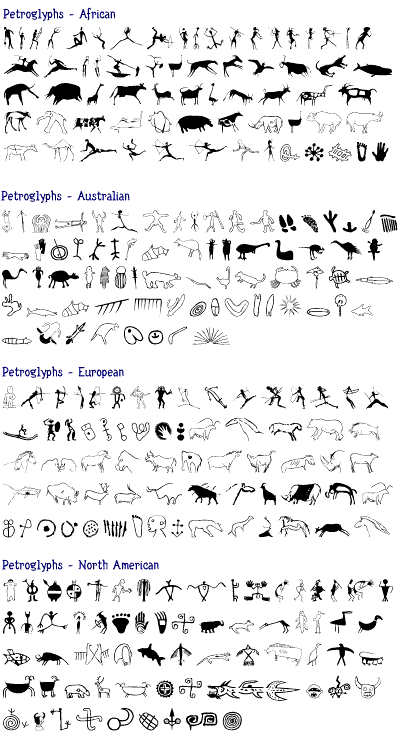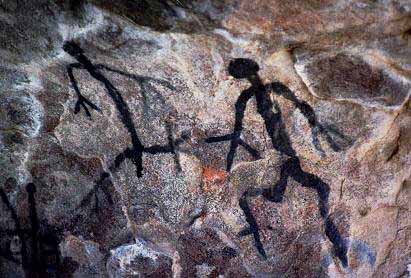

Petroglyphs Images Carved into Rock Face
Petroforms Human-made Boulder Forms
Geoglyphs Large Motifs on the Ground
Pictographs or Pictograms are images painted on a rock face. Paints were generally made from pulverized minerals. Red, white, and black were the most common colors.
A pictogram is a symbol representing an object or concept by illustration. Pictography is a form of writing whereby ideas are transmitted through drawing. It is the basis of cuneiform and hieroglyphs.
Early written symbols were based on pictograms, pictures which resemble what they signify, and ideograms, pictures which represent ideas; it is commonly believed that pictograms appeared before ideograms. They were used by various ancient cultures all over the world since around 9000 BC and began to develop into logographic writing systems around 5000 BC. Pictograms are still in use as the main medium of written communication in some non-literate cultures in Africa, The Americas, and Oceania, and are often used as simple symbols by most contemporary cultures.
The earliest uses of pictograms in Mesopotamia predated the famous Sumerian cuneiforms (oldest of which date to around 3400 BC). As far as around 9000 BC tokens marked with simple pictures began to be used to label basic farm produce, and around 6000 BC, with the rise of cities and spread of basic craftsmanship more complex pictographic tokens were devised to label manufactured goods. Eventually, the tokens were replaced by clay tablets, on which symbols were drawn with a blunt reed called a stylus. The impressions left by the stylus were wedge shaped, thus giving rise to the name cuneiform, wedge-writing.
Though written Chinese is often thought of consisting of pictograms, less than 1% of all characters ever created have their direct origins in pictograms. The letters of the Roman alphabet, however, do have their origins in pictograms. For example, the letter A represented the head of an ox, and if it is turned upside down, a bovine head with horns can be seen.
Pictograms remain in common use today, serving as signs or instructions. Because of their graphical nature and fairly realistic style, they are widely used to indicate public toilets, or places such as airports and train stations. However, even these symbols are highly culture-specific. For example, in some cultures men commonly wear dress-like clothing, so even restroom signage is not universal. Pictographic writing as a modernist poetic technique is credited to Ezra Pound though French surrealists accurately credit the Pacific Northwest American Indians of Alaska who introduced writing, via totem poles, to North America (Reed 2003,p.XIX).
A standard set of pictograms was defined in the international standard ISO 7001: Public Information Symbols. Another common set of pictograms are the laundry symbols used on clothing tags and chemical hazard labels.In countries or regions where two or more languages are used, the typical traffic sign is very often a symbol with no writing on it. This is the case for much of Europe and several parts of Canada. Many of these signs, however, offer an abstract symbol instead of a picture, and they cannot be considered true pictograms.
The Ghost Panel
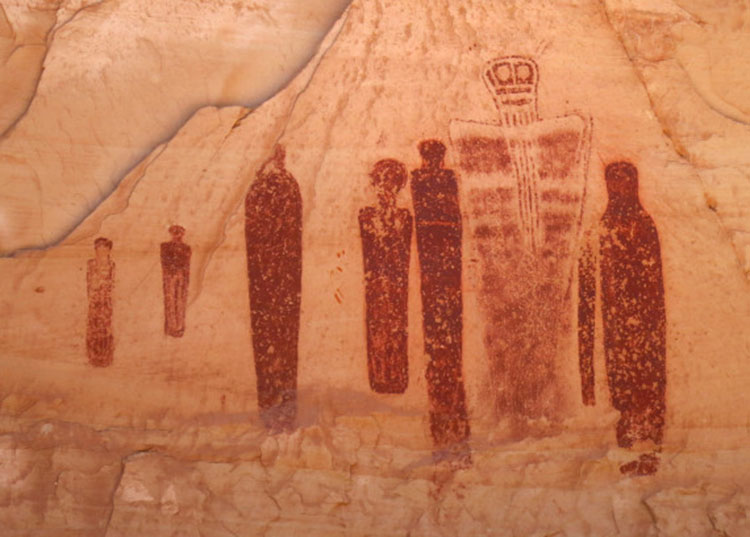
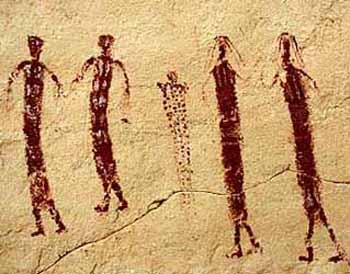
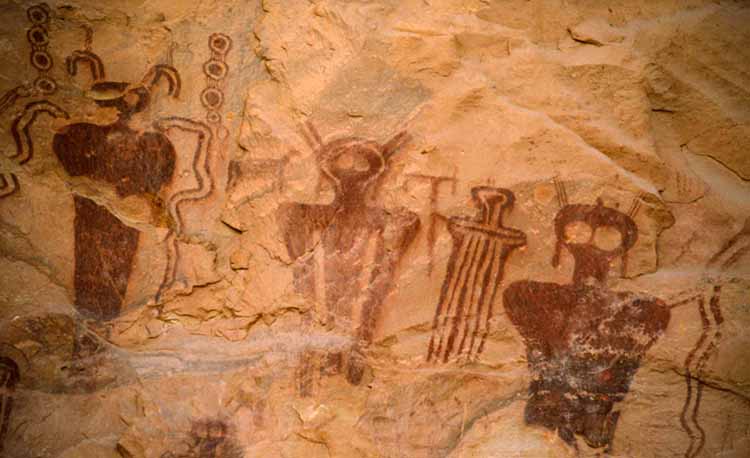
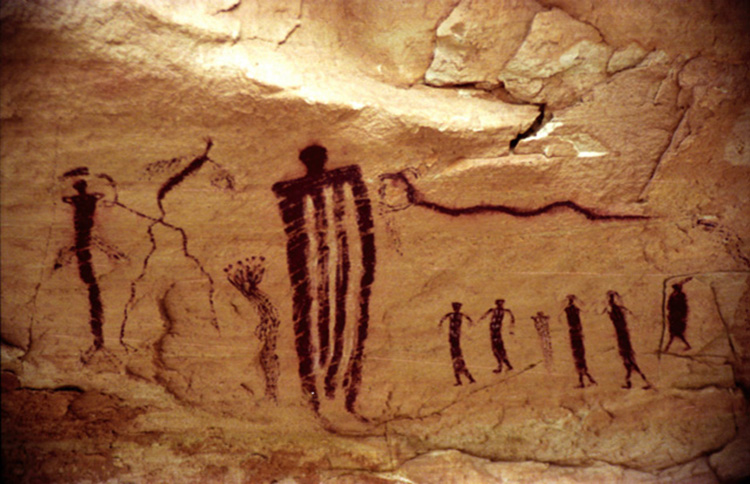
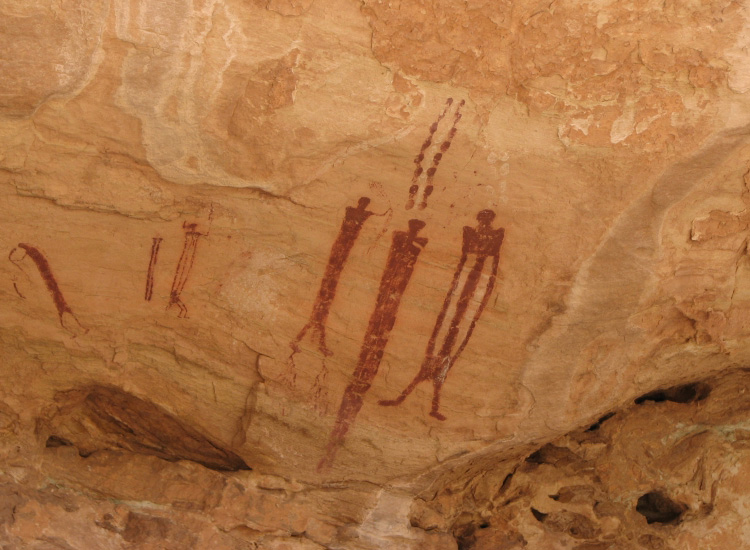
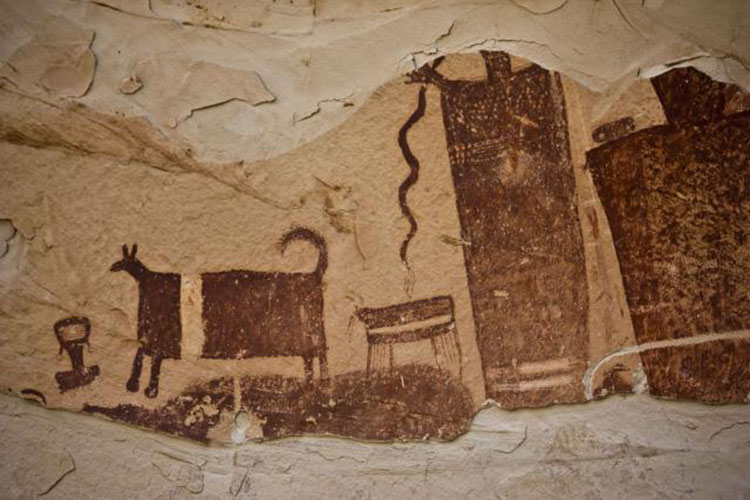
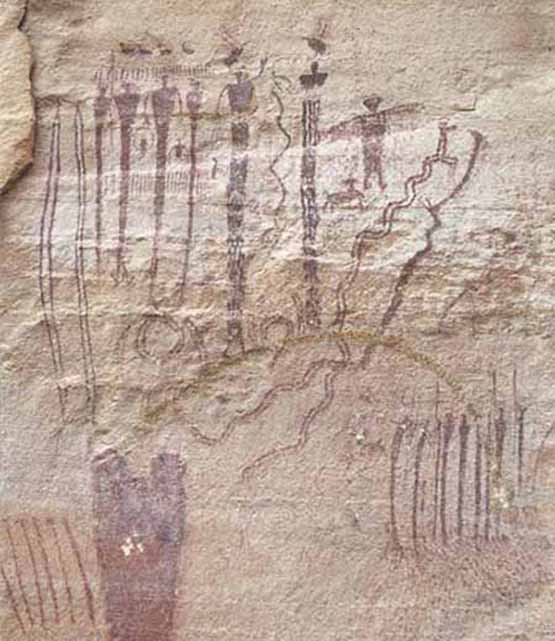
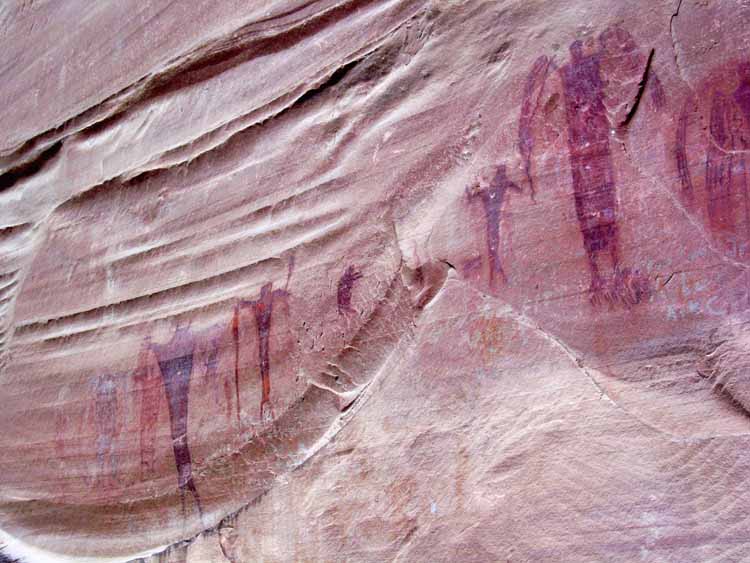
Mythology: Hopi Ant People, Snake People, Blue Kachina, Star Gods
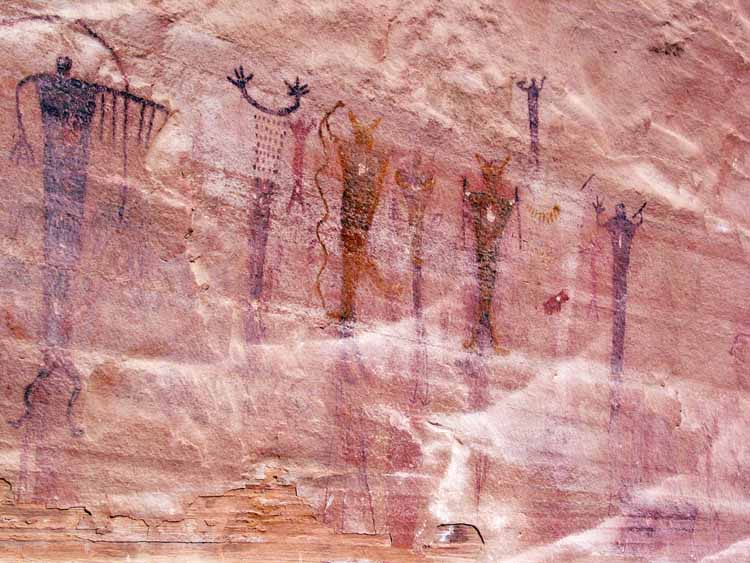
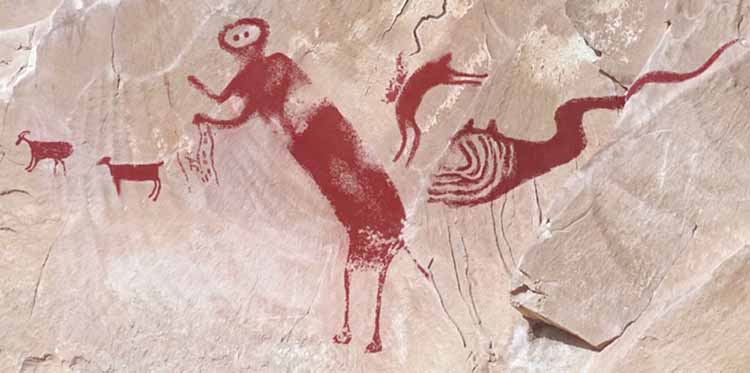
'Winged Monster' Rock Art Finally Deciphered Live Science - August 18, 2015
The mystery surrounding the ancient rock paintings of Utah's Black Dragon Canyon has finally been solved. For decades, researchers and creationists have debated whether the vibrant red pictographs are images of humans and animals, or rather, depictions of a large winged monster, possibly a pterosaur.
Now, using cutting-edge technology, researchers suggest the red paintings show five separate images, including a tall bug-eyed person, a smaller person, a sheep, a dog and a serpentlike figure. The rock paintings belong to the agrarian Fremont culture (circa A.D. 1 to 1100). Other Fremont rock paintings - known as Barrier Canyon style - show abstract humanlike figures with elongated bodies and round heads, the researchers wrote in the study. These long figures are usually accompanied by tiny "attendants," including people, birds and four-legged creatures, such as hoofed animals, canines, felines, badgers and bears.
The fossils of pterosaurs, flying reptiles that lived from 228 million to 66 million years ago, are found in the region. Some creationists began saying that the painting was a real-life impression of pterosaurs that lived at the same time as humans, and a few people even tried to identify the species, saying it was Quetzalcoatlus northropi, a reptile with a wingspan of about 39 feet (12 meters), Bahn said. (Many creationists believe the Earth is just several thousand years old, instead of about 4.5 billion years old, and as such humans and dinosaurs would have lived together.) But to many researchers, the painted area clearly shows separate images, not a single image of a pterosaur.
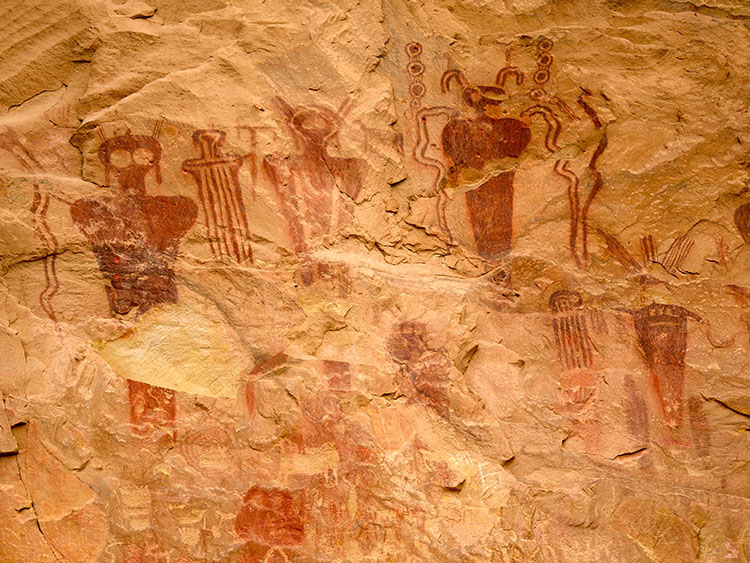
Evidence of human habitation or use of the Thompson Springs area can be dated back to the Archaic Period, when beautiful Pictographs were left in Sego Canyon. Subsequent Anasazi, Fremont, and Ute tribes have also left their mark upon the area.
Thompson Springs is also the site of several well-preserved groups of pictographs and petroglyphs left by early Native Americans. The Fremont culture thrived from A.D. 600 to 1250 and was a contemporary with the Anasazi culture of the Four Corners area. There is also rock art from the Archaic period dating from 7000 B.C., the Barrier Canyon period from around 2000 B.C., and the Ute tribe dating from A.D. 1300.
Ancient Rock Art Is Scattered Throughout The Grand Canyon - But You'll Never Know Where IFL Science - July 23, 2024
The Grand Canyon is a spectacular sight to behold in and of itself, but did you know the surrounding national park is also home to a wealth of prehistoric rock art? Don't be disappointed if you didn't - the exact whereabouts of the vast majority of it remains a closely guarded secret. Take Shamans’ Gallery, a site that most people would never have heard of were it not for word-of-mouth and later, the Internet. First recorded in 1987 and named by American archaeologist Polly Schaafsma, it features a large panel of rock art paintings - called pictographs - depicting anthropomorphic characters, deer, birds, and other abstract features.
Its style has been described as Grand Canyon or Esplanade Polychrome, the latter after the distinctively red and tan bed of sandstone that forms the canyon and though it can be difficult to precisely date rock art, it’s estimated to date back to the Archaic period, which lasted from around 8500 BCE to roughly 2000-1000 BCE.
Ancient Alien Theory would say these giants were aliens. I say they were AI which were aliens.
Rock Art Featuring Ice Age Giants Proves Humans Settled The Amazon 12,600 Years Ago Live Science - February 20, 2024
A new analysis of human activities at two prehistoric sites in the Colombian Amazon has revealed that people were well established in the region by around 13,000 years ago. By studying layers of soil, researchers were able to tease out the long-term history of both settlements, indicating that the ancient inhabitants began producing rock art more than 10,000 years ago and eventually took up farming some eight millennia later. The 'peopling’ of South America represents one of the great migrations of human history - but their arrival into the Amazon biome has been little understood. Recent excavations, however, help to fill this gap, not only dating their arrival to much earlier than previously understood, but also providing novel insights into their lives and historical trajectories during the Holocene.
4,000-year-old rock art in Venezuela may be from a 'previously unknown' culture Live Science - July 2, 2024
An archeological team in Venezuela has discovered 20 rock art sites that date back thousands of years in Canaima National Park, in the southeastern part of the country. While archaeologists have found similar rock art designs elsewhere in South America, the newfound art "represents a new culture previously unknown. Some of these designs, which researchers call "pictograms," were drawn in red and depict geometric motifs such as lines of dots, rows of X's, star-shaped patterns and straight lines that connect together to form a variety of designs. There are also simple depictions of leaves and stick figure drawings of people. Additionally, some of the images, called petroglyphs, were incised into the rock and also show a variety of geometric motifs
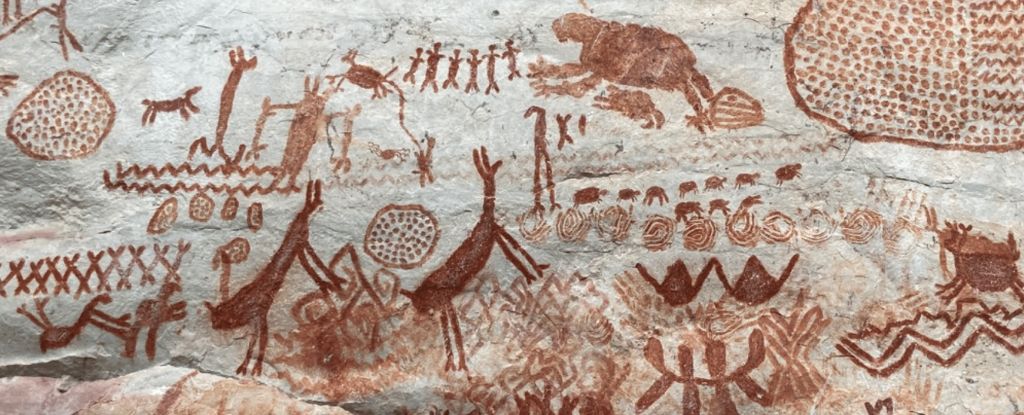
Ancient Rocks in The Amazon Reveal a Glimpse of The Spirit Realm
Science Alert - November 13, 2024
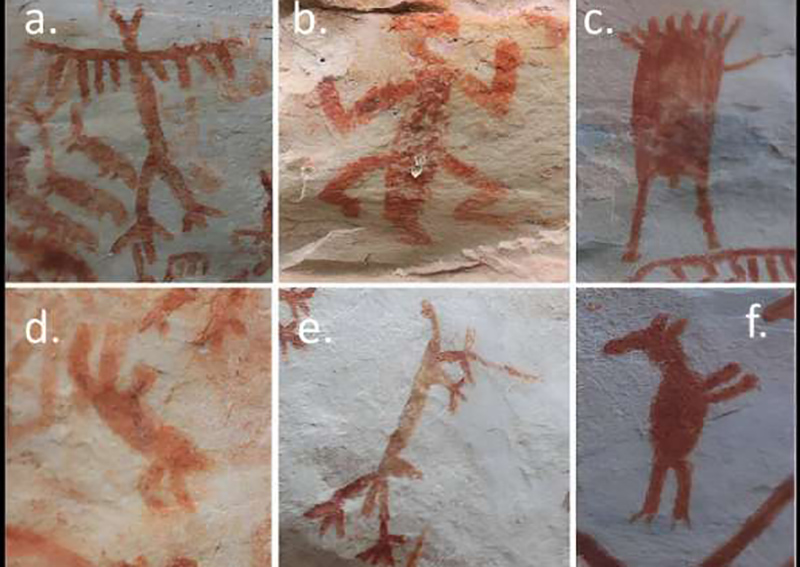
Rock art and archaeological record reveal man's complex relationship with Amazonian animals PhysOrg - July 25, 2024
Rock art explored by archaeologists in the Colombian Amazon has provided an insight into the complex relationship between the earliest settlers on the continent and the animals they encountered. Spectacular ocher paintings of a wide variety of animal species, including depictions of animals and humans transforming into one another, indicate the rich mythology that guided generations of indigenous Amazonians. And while the images found adorning the rocky outcrop of Cerro Azul in the Serrania de la Lindosa have yet to be accurately dated, associated evidence of human activity suggests they are likely to have served as galleries for thousands of years, as far back as 10,500BC.
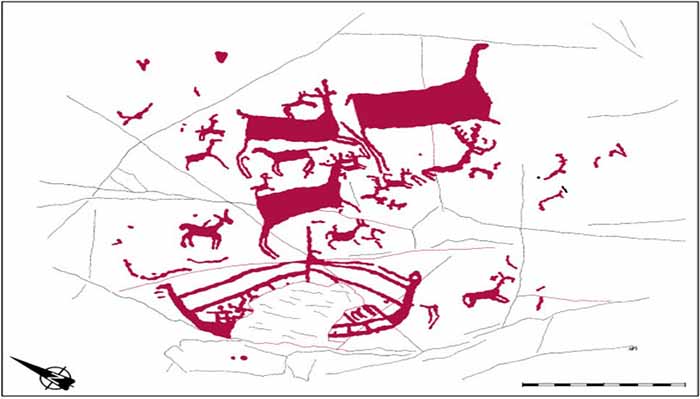
Rock art may Memorialize Ancient Contact between Atlantic and Mediterranean Ancient Origins - October 8, 2015
A meeting of the peoples of the European Atlantic coast and the Mediterranean coast may be memorialized in an ancient rock carving of a sailing vessel in the north of Spain. Sailing vessels were native to the Mediterranean, while rowing vessels were used on the Atlantic coast, where the petroglyph is located. Along the Atlantic coast of northwestern Spain in Galicia, is an unusually high concentration of rock art, according to Dig Ventures. This sailing vessel scratched into a rock surface in the Costa de Castros region is unique in the known Bronze Age rock art of the Atlantic coast, though many boats are depicted in rock art along that coast.
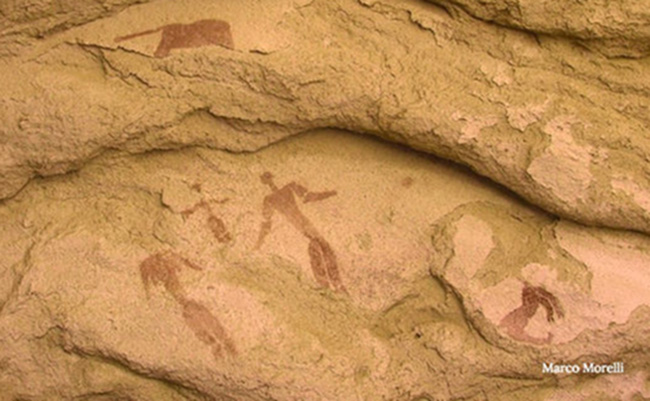
5,000-Year-Old Nativity Scene Found in Egypt Live Science - December 26, 2016
Italian researchers have discovered what might be the oldest nativity scene ever found - 5,000-year-old rock art that depicts a star in the east, a newborn between parents and two animals. The scene, painted in reddish-brown ochre, was found on the ceiling of a small cavity in the Egyptian Sahara desert, during an expedition to sites between the Nile valley and the Gilf Kebir Plateau. The scene features a man, a woman missing the head because of a painting detachment, and a baby. The newborn is drawn slightly above, as if raising to the sky. Such position, with the baby not yet between the parents, would have meant a birth or a pregnancy. On the upper part is a headless lion, a mythical beast which appears in several rock art drawings from the same area, while below in the scene a baboon or an anthropomorphic monkey can be seen. In the east, the Neolithic artist drawn what appears to be star. The researchers called the site the "Cave of the Parents." No doubt it's an intriguing drawing. They didn't find similar scenes until the early Christian age.
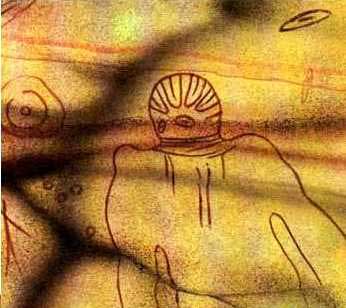
Tassili n'Ajjer, Sahara Desert, North Africa
Sahara rock art is a significant area of archaeological study focusing on the precious treasures carved or painted on the natural rocks found in the central Sahara desert. There are over three thousand sites discovered that have information about Saharan rock art. From the Tibesti massif to the Ahaggar Mountains, the Sahara is an impressive open-air museum containing numerous archaeological sites.
Tassili n'Ajjer (meaning "Plateau of the Rivers") is noted for its prehistoric rock art and other ancient archaeological sites, dating from Neolithic times when the local climate was much moister, with savannah rather than desert. The art depicts herds of cattle, large wild animals including crocodiles, and human activities such as hunting and dancing. The art has strong stylistic links to the pre-Nguni Art of South Africa and the region, executed in caves by the San Peoples before the year 1200 BCE.
The range's exceptional density of rock art paintings-pictograms and engravings-petroglyphs, and the presence of many prehistoric vestiges, are remarkable testimonies to Neolithic prehistory. From 10,000 BCE to the first centuries CE, successive peoples left many archaeological remains, habitations, burial mounds and enclosures which have yielded abundant lithic and ceramic material. However, it is the rock art (engravings and paintings) that have made Tassili world famous as from 1933, the date of its discovery. 15,000 petroglyphs have been identified to date.
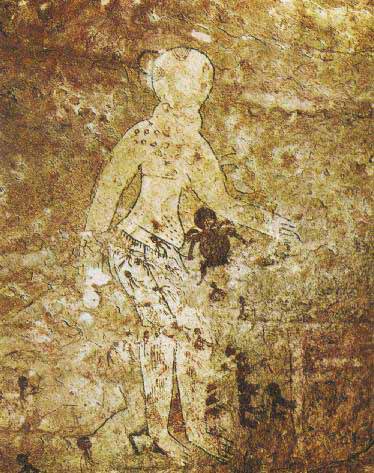
Some of the painting have bizarre depictions of what appear to be spacemen wearing suits, visors, and helmets. resembling modern day astronauts. This takes us to the west African tribe - the Dogon whose legends say they were guided to the area from another part of Africa that was drying up - by fish gods called the Nommo who came in huge ships from the sky.
9,000-year-old rock art of people swimming in what's now the arid Sahara Live Science - September 23, 2024
What it tells us about the past: Thousands of years ago, the Sahara Desert was not the dry, sandy landscape we know it as today - it was a lush, green oasis. In fact, the sandstone-rich Gilf Kebir plateau, which stretches from southwestern Egypt into southeastern Libya and is where the rock art resides, offers further evidence that this swath of land was once accessible to bodies of water and not always a barren desert.
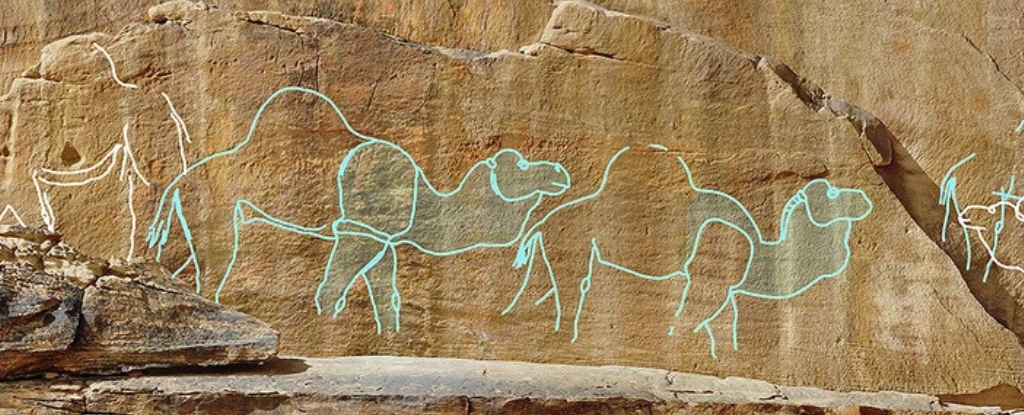
12,000-Year-Old Desert Rock Art in Arabia Conveyed Important Message For Ancient People Science Alert - October 1, 2025
About 12,000 years ago, high up on a cliff in the desert of northern Arabia, an artist - or perhaps artists - was hard at work. Standing on a narrow ledge and with primitive tools, they engraved into the rock an image of a life-sized camel. This wasn't the first artwork of its kind: in fact, there was already an entire row of fresh camel engravings on the 39-metre-high cliff face, below which a shallow lake sparkled in the sunshine. Over thousands of years, these engravings weathered the elements. They gradually eroded until they were almost invisible and had been forgotten.
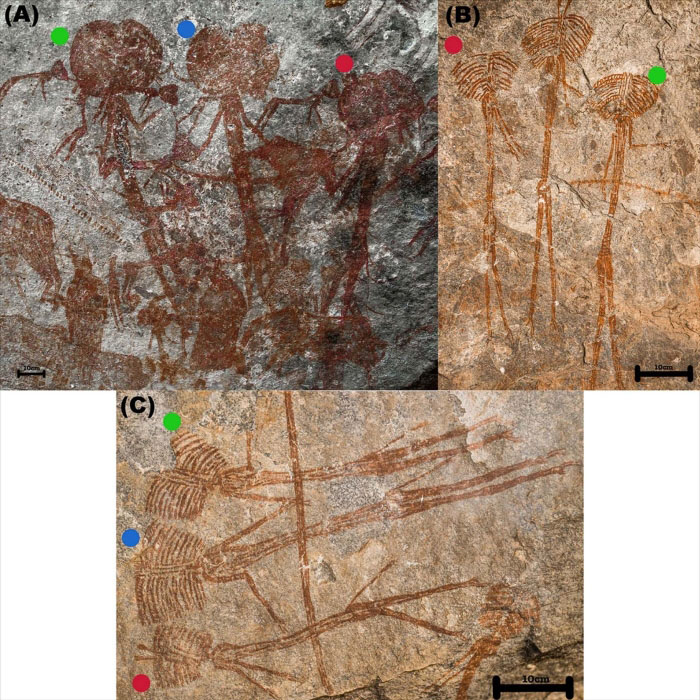
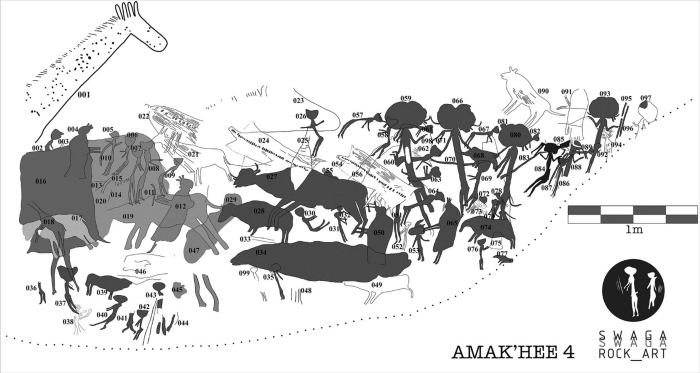
Creepy Figures With Huge Heads Found Painted in a Rock Shelter in Tanzania Science Alert - November 25, 2023
All three sites show similar figures, with large heads, although the Kolo figures sport a striped motif, interpreted as a headdress. (Other Kondoa figures are interpreted as having elaborate hairstyles). The Amak'hee 4 panel is difficult to date. It's painted almost entirely in red pigment, except for five figures in white. In all three sites, the figures are connected by a line across their midsection. And all three have similar arrangements and directions of the hands and arms.
Ellie - the figures look like gray aliens or artificial intelligence found across the world. The same could be said for the animals depicted here.
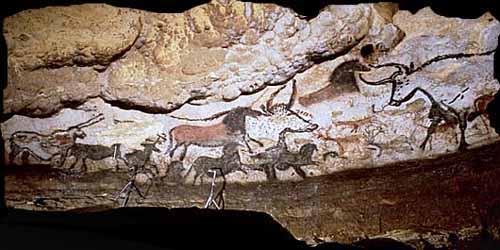
Cave or rock paintings are paintings painted on cave or rock walls and ceilings, usually dating to prehistoric times. Rock paintings are made since the Upper Paleolithic, 40,000 years ago. It is widely believed that the paintings are the work of respected elders or shamans.
When Europeans first encountered the Magdalenian paintings of the Altamira cave, Cantabria, Spain in 1879, they were considered to be hoaxes by academics. The new Darwinian thinking on evolution was interpreted as meaning that early humans could not have been sufficiently advanced to create art. Emile Cartailhac, one of the most respected prehistorians of the late nineteenth century believed they had been thought up by Creationists to support their ideas and ridicule Darwin's. Recent reappraisals and increasing numbers of discoveries have illustrated their authenticity and indicated the high levels of artistry of Upper Palaeolithic humans who used only basic tools. Cave paintings can also give valuable clues as to the culture and beliefs of that era.
The age of the paintings in many sites remains a contentious issue, since methods like radiocarbon dating can be easily misled by contaminated samples of older or newer material, and caves and rocky overhangs are typically littered with debris from many time periods. The choice of subject matter can indicate date such as the reindeer at the Spanish cave of Cueva de las Monedas which imply the art is from the last ice age. The oldest cave is that of Chauvet, and is 32,000 years old.
The most common themes in cave paintings are large wild animals, such as bison, horses, aurochs, and deer, and tracings of human hands as well as abstract patterns, called Macaroni by Breuil. Drawings of humans are rare and are usually schematic rather than the more naturalistic animal subjects. Cave art may have begun in the Aurignacian period (Hohle Fels, Germany), but reached its apogee in the late Magdalenian (Lascaux, France).
The paintings were drawn with red and yellow ochre, hematite, manganese oxide and charcoal. Sometimes the silhouette of the animal was incised in the rock first. Stone lamps provided some light. Abbe Breuil interpreted the paintings as being hunting magic, meant to increase the number of animals. As there are some clay sculptures that seem to have been the targets of spears, this may partly be true, but does not explain the pictures of beasts of prey such as the lion or the bear. An alternative and more modern theory, based on studies of more modern hunter-gatherer societies, is that the paintings were made by Cro-Magnon shaman.
The shaman would retreat into the darkness of the caves, enter into a trance state and then paint images of their visions, perhaps with some notion of drawing power out of the cave walls themselves. This goes some way towards explaining the remoteness of some of the paintings which often occur in deep or small caves and the variety of subject matter (from prey animals to predators and human hand-prints). However, as with all prehistory, it is impossible to be certain due to the relative lack of material evidence and the many pitfalls associated with trying to understand the prehistoric mindset with a modern mind.
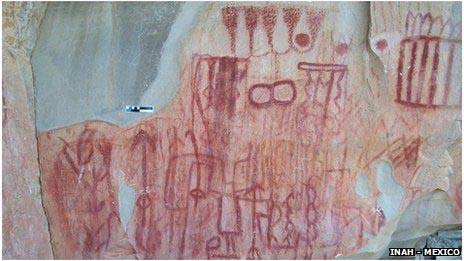
Cave paintings in Mexico: Carvings uncovered in Burgos
Archaeologists in Mexico have found 4,926 well-preserved cave paintings in the north-eastern region of Burgos. The images in red, yellow, black and white depict humans, animals and insects, as well as skyscapes and abstract scenes. The paintings were found in 11 different sites - but the walls of one cave were covered with 1,550 scenes. The area in which they were found was previously thought not to have been inhabited by ancient cultures. The paintings suggest that at least three groups of hunter-gatherers dwelled in the San Carlos mountain range. Experts have not yet been able to date the paintings, but hope to chemically analyse their paint to find out their approximate age.
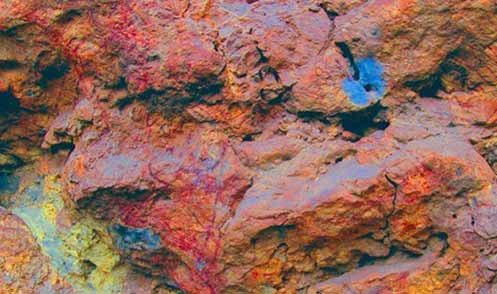
New evidence of ancient rock art across Southeast Asia Science Daily - November 26, 2014
A bull from the Xianrendong rock art site (Yunnan, China) is a natural projection of stone that resembles a profile animal. It was painted with red ochre to highlight the head, front legs and side of the body. The head has a natural hole for an eye. The latest research on the oldest srviving rock art of Southeast Asia shows that the region's first people, hunter-gatherers who arrived over 50,000 years ago, brought with them a rich art practice.
Research on the oldest surviving rock art of Southeast Asia shows the region's first people brought with them a rich art practice. These earliest people skillfully produced paintings of animals in rock shelters from southwest China to Indonesia. Besides these countries, early sites were also recorded in Thailand, Cambodia and Malaysia. The oldest paintings were identified by analyzing overlapping superimpositions of art in various styles as well as numerical dating. It was found that the oldest art mainly consists of naturalistic images of wild animals and, in some locations, hand stencils.
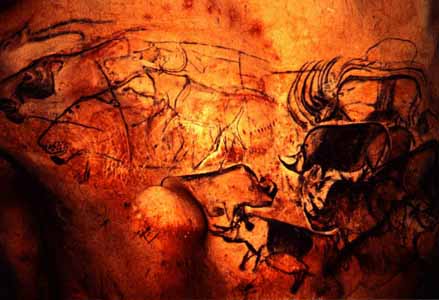
Caves at Lascaux, France
Lascaux is a complex of caves in southwestern France famous for its cave paintings. The original caves, located near the village of Montignac. They contain some of the earliest known art, dating back to somewhere between 13,000 and 15,000 BCE, or as far back as 25,000 BCE.
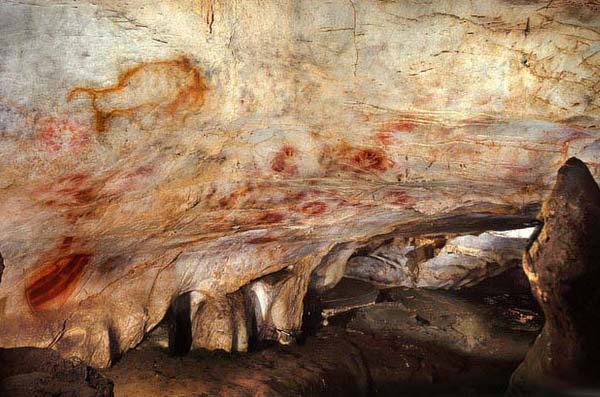
Red dot becomes 'oldest cave art'
BBC - June 14, 2012The El Castillo Cave in Spain -- The refined dating shows these paintings to be far older than anyone thought. Red dots, hand stencils and animal figures represent the oldest examples yet found of cave art in Europe. The symbols on the walls at 11 Spanish locations, including the World Heritage sites of Altamira, El Castillo and Tito Bustillo have long been recognized for their antiquity. But researchers have now used refined dating techniques to get a more accurate determination of their ages. One motif - a faint red dot - is said to be more than 40,000 years old.
When archaeologists tried out a new technique to determine the age of Spain's most famous Paleolithic cave paintings, they were surprised to discover that the paintings were thousands of years older than previously thought - so old that it's conceivable they were painted by Neanderthals. The technique just might change the way we think about the paintings, and the way we think about our long-extinct, long-maligned Neanderthal cousins as well.
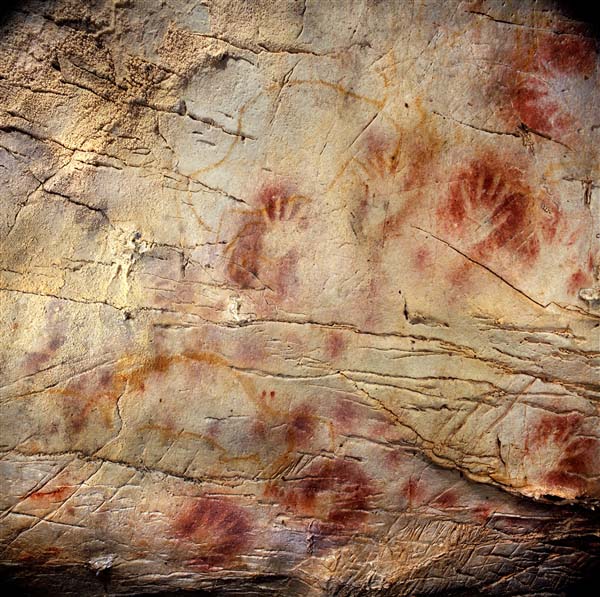
Hand stencils and the outlines of animals dominate "The Panel of Hands" in Spain's El Castillo cave. One of the stencils has been dated to earlier than 37,300 years ago, and a red disk goes back at least 40,800 years, making them the oldest cave paintings in Europe.
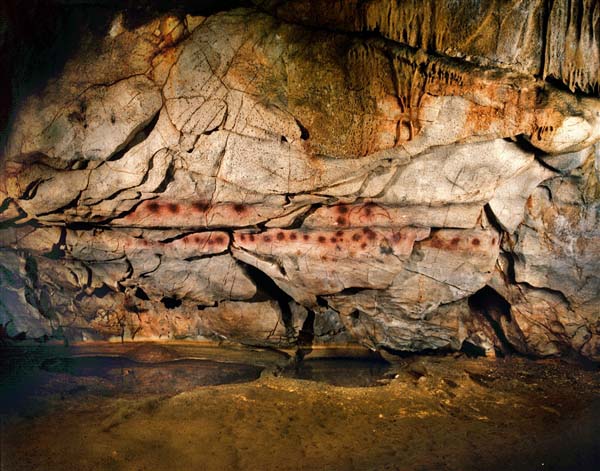
The "Corredor de los Puntos" lies within Spain's El Castillo cave. Red disks here have been dated to between 34,000 and 36,000 years ago, and elsewhere in the cave to 40,800 years ago, making them examples of Europe's earliest cave art
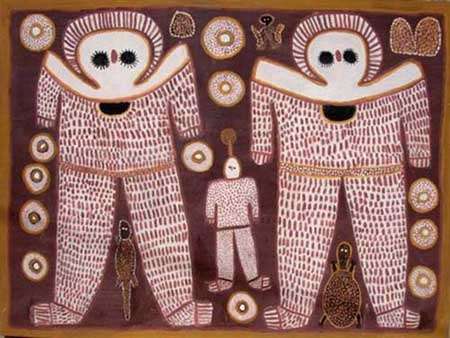
Wandjina People
who look like Gray Aliens and Other Cave Paintings and more
Mysterious rock art painted by Aboriginal people depicts Indonesian warships
Live Science - June 15, 2023
Hundreds of years ago, in a cramped cave, Indigenous people in Australia painted a pair of watercraft whose origins have puzzled archaeologists since the artworks' discovery about 50 years ago. Now, a new study may have solved the mystery: The paintings likely depict "fighting craft" from what is now Indonesia, hinting that there may have been "physical violence" between the Indigenous people and visitors from afar.
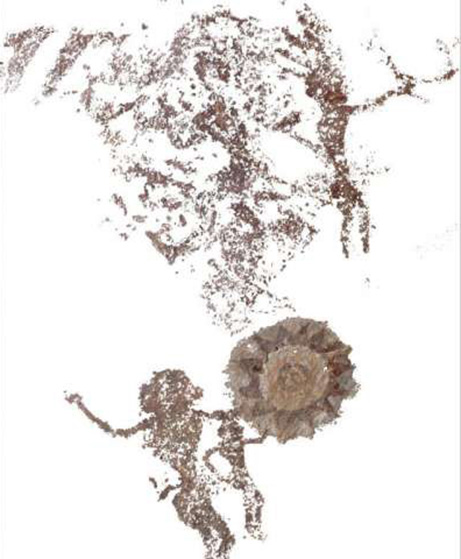
Indonesian island found to be unusually rich in cave paintings
